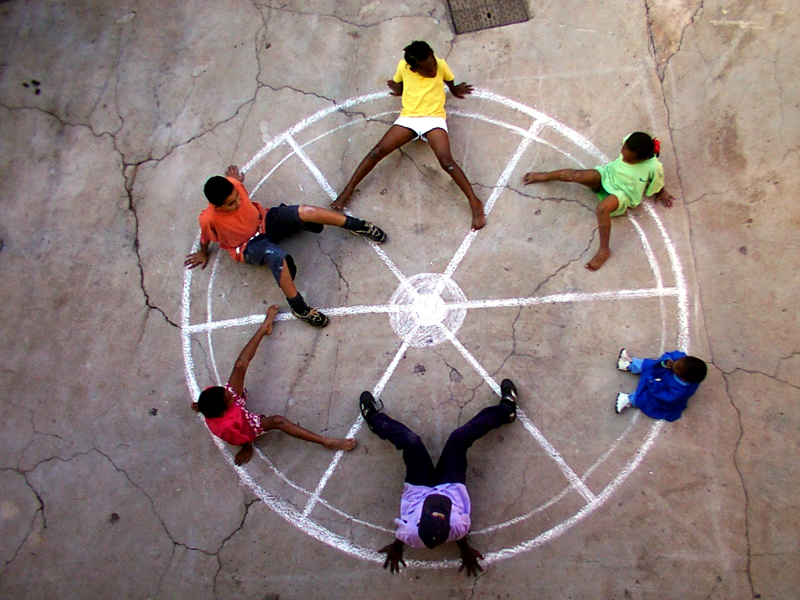This was the fifth time I’d gone to ABMB (Art Basel Miami Beach) and the multi-ring circus that includes the peripheral art fairs, local museums, collectors who run private museum spaces, temporary public projects and various lectures, performances, film showings and parties. I decided to take it easy and be guided by the interests of several friends who were also in Miami for the events, spending two days with tv news producer, Jake Haselkorn, who’s spent the past 20 years covering Asia and my good friend, Berta Sichel, Director of the Film Department at the Reina Sophia Museum, Madrid, as well as meeting up with Artblog’s Roberta and Libby for a day. The following are random snapshots rather than any attempt at a synthesis.


Berta had curated the exhibition, Being in the World; Selections from the Ella Fontanals-Cisneros Collection at C.I.F.O (the Cisneros Fontanals Art Foundation), one of Miami’s private museums. The exhibition explores video work by Bill Viola, Shirin Neshat, Chantal Ackerman and four other artists or artist collaborations.

The selection investigated the work against the background of Jean-Paul Sartre’s idea of situation as a way of exploring both the literal and metaphorical displacement accompanying current globalization and the previous cultural habits and experiences that migrants inevitably bring to new circumstances.

CIFO hosted a brunch which was notable not only for the food and elegant floral decorations set within tents outside the exhibition space, but also for the amazing range of footwear worn by the female guests. I wasn’t in Kansas or Philadelphia anymore!


Ackerman’s D’est: au board de la fiction was the highlight of the artwork on view, a piece that doesn’t loose its power no matter how many times I see it. It was the first time I’d seen Neshat’s powerfully-wrenching short piece, Zarin (2005), a straight-forward single-channel narrative in color. I can only assume it presages her approach to film in the feature-length Women Without Men for which Neshat won the Best Director award at this year’s Venice Film Festival.
I caught up with Susan Sterling, Director of the National Museum of Women in the Arts, Washington, D.C. who was escorting members of her Director’s Circle around C.I.F.O.’s exhibition. Susan and I co-curated an exhibition of Carrie Mae Weems’ work in the early 1990s, and later in the day I ran into Carrie herself. That was a great reunion. Carrie has been making videos, one of which, exploring her long interest in male/female relations,was prominently on view at Photo Miami .

The other private museum I saw was the Margulies Collection at The Warehouse . Miami’s private museums surely represent more square footage devoted to contemporary art than in any city in the world, and none is more impressive than the collection put together by real estate developer, Martin Z. Margulies.

I’d known Marty and his curator, Katherine Hinds since 1984 and was delighted to introduce them to Roberta and Libby. The collection’s recent acquisitions emphasize video and photography (Penn photography students curated an exhibition from the collection which was reviewed here) although there was also sculpture by younger artists as well as a major installation by Michael Heizer and significant work by George Segal, Miro and Noguchi.

Unlike most of Miami’s other private collections as well as most public museums these days, in the U.S. and Europe, Margulies’ collection goes beyond the handful of artists who are the current fashion; this not only gives it a personal stamp, but also means that even seasoned art professionals are certain to be introduced to new artists. I certainly saw artists I didn’t know. One area was installed around urbanistic themes: Anri Sala’s video, Dammi I Colori (2003) which pans the newly polychrome housing in Tirana; Courtney Smith’s Paraparquetry (2007) which employs re-used wood from old furniture to create a multi-dimensional parquet floor that resembles a cityscape;

and Peter Belyi’s Danger Zone (2007), a model of a distopian city of the future whose failed modernist towers have crumbled to rubble. Belyi is a sort of Piranesi of the 21st century, creating a sci fi romanticism of ruins.










